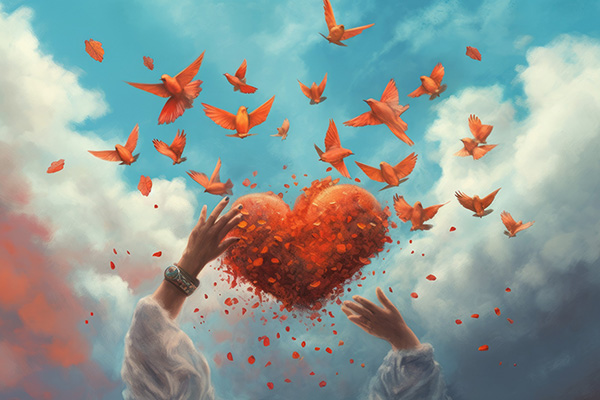nature
The Miraculous Roll Of Film
 I have experienced many miracles and magical events in my life. As you read the following incredible story, you will see why I have chosen this particular one to best illustrate my experiences.
I have experienced many miracles and magical events in my life. As you read the following incredible story, you will see why I have chosen this particular one to best illustrate my experiences.
When I was 18 years old, I was working at a pre-school in my home town. One of the pupils was a three-year-old girl with whom I felt a real connection. She was an old soul; a bright and talented young artist.
But she usually came to school with unwashed, unbrushed hair and dirty clothes. She would never bring a packed lunch. When her parents came to collect her from school, they were often late and, unlike the other children, she did not run into their arms. There was clearly a disconnect between parent and child.
Eventually I moved several hours away and stopped working at the school. But I still thought of her often and prayed that she was well. A few years after I left, I made some enquiries, but no one knew what had happened to her. I hope she survived her difficult childhood and continued to create art, which I believed may have been her saving grace.
Two decades later, I was visiting the area around my hometown to go hiking with friends in a nearby national park. One day, one of my friends climbed a big rock and I followed him. Then he jumped down and I noticed what looked like something he had accidentally left behind.
“Hey, you dropped your roll of film up here,” I shouted, holding up the roll I’d found on the rock. But it turned out not to be his film and that someone else must have left it there. Maybe that person had the same idea of climbing the rock to take some pictures of the magnificent view.
Envisioning A Better World For All
 More than a century ago, the great Indian sage Paramahansa Yogananda spoke in his teachings and writings about envisioning a better world for all. He believed in the transformative power of individual and collective consciousness and emphasized the importance of spiritual practices such as meditation and self-realization in creating a more harmonious and compassionate world.
More than a century ago, the great Indian sage Paramahansa Yogananda spoke in his teachings and writings about envisioning a better world for all. He believed in the transformative power of individual and collective consciousness and emphasized the importance of spiritual practices such as meditation and self-realization in creating a more harmonious and compassionate world.
Yogananda stressed that true change begins within each individual. He believed that by working on our own spiritual growth and self-realization, we radiate positive energy and higher consciousness that contributes to a more peaceful and loving world.
He encouraged individuals to envision a new world of peace, harmony, and unity. By holding this vision in our minds and hearts, he believed, we could collectively bring it into being. Yogananda promoted the concept of universal brotherhood, which recognizes the interconnectedness of all beings. He encouraged people to look beyond differences of race, religion, and nationality and to treat one another with love, respect, and understanding.
Yogananda also spoke of the power of visualization and positive thinking. He saw prayer and meditation as powerful tools for individual and collective transformation. He encouraged individuals to live with a sense of purpose and to align their actions with higher ideals.
In a modern world filled with challenges and uncertainties, it is indeed essential that we hold on to a common vision of a better future. We must strive to create a world in which every individual, regardless of background or circumstance, can thrive.
Embrace The Fall Equinox In Mind, Body And Soul
 As the vibrant colors of summer begin to fade and the air becomes crisper in the northern hemisphere, we stand on the threshold of the fall season of transition and transformation. It is a sacred time to prepare our minds, spirits, and bodies for the winter months ahead.
As the vibrant colors of summer begin to fade and the air becomes crisper in the northern hemisphere, we stand on the threshold of the fall season of transition and transformation. It is a sacred time to prepare our minds, spirits, and bodies for the winter months ahead.
Today’s autumnal equinox is a poignant reminder of the cycles of life and the eternal rhythm of nature. Steeped in ancient tradition and folklore, this celestial event occurs each year around September 21st and marks the point at which day and night are of nearly equal duration. Spiritually, it symbolizes equilibrium; a momentary pause in time between the warmth of summer and the cold of winter. It invites us to reflect on balance and harmony.
Ancient civilizations held a deep reverence for celestial events such as the autumnal equinox, which were often seen as significant markers of time and the cycles of nature. The traditional interpretations and beliefs surrounding the autumnal equinox varied from culture to culture, but they generally recognized its importance in agricultural, spiritual, and cultural contexts, and saw it as a time of transition, balance, and connection between heaven and earth.
In many agricultural societies, the autumnal equinox signaled the time of the year’s harvest. The ancient Egyptians and Babylonians celebrated this event with festivals and rituals dedicated to their agricultural deities. This often included feasting, music, and offerings to ensure a bountiful harvest.
Keep Seeking The Light Beyond The Darkness
 I do a trivia quiz almost every day to keep my mind stimulated and strong. This morning the question was: What is achluophobia? Well, it is the fear of the dark, which is a somewhat reasonable phobia since we instinctively want to be able to see what is going on around us in order to survive. However, as I thought about it more, I realized that we also have the same need to ‘see the light’ on a spiritual level.
I do a trivia quiz almost every day to keep my mind stimulated and strong. This morning the question was: What is achluophobia? Well, it is the fear of the dark, which is a somewhat reasonable phobia since we instinctively want to be able to see what is going on around us in order to survive. However, as I thought about it more, I realized that we also have the same need to ‘see the light’ on a spiritual level.
The darkness of evil, hatred and despair is always out there, lurking in the background, trying to sneak into our hearts and minds and take over. There is a spiritual war going on in our hearts and minds every day.
As we are increasingly drawn into the darkness, we are also increasingly hit with setbacks, hurdles, heartaches, and hardships. Then, in our entitlement and arrogance, we wonder why God, Source, Spirit, the Divine, is not doing anything to help us? Why have we been abandoned? Is there even a higher, divine power that can come to our aid?
It is amazing how many people at one time or another indulge in the thought, the notion that the very God, Source, Spirit, Divine, Universe that guides, protects and provides for us, actually takes the time to also hate, punish or destroy us.
All we have to do is observe the miracle of nature to know that this is not true. Every little miracle of nature, every tree and plant, every stone, every living being has a reason and a purpose to exist in the wonderful mechanics of our planet.
Turn Your Home Into A Sacred Space
 How many times have you needed a timeout, or place of refuge to clear your mind? Seeking peace and balance is vital, with all of the breakdowns and breakthroughs occurring in our personal lives, and the world today. This is why making your home a scared space is essential to your energetic well-being and mental health.
How many times have you needed a timeout, or place of refuge to clear your mind? Seeking peace and balance is vital, with all of the breakdowns and breakthroughs occurring in our personal lives, and the world today. This is why making your home a scared space is essential to your energetic well-being and mental health.
For me, an energetically healthy home is a reflection of who I am spiritually and what I believe. We all have a unique story that is to be expressed in our immediate environment, thus making it holy and sacred.
When you infuse your home or a room with your divine essence, you are creating Heaven on Earth and raising the vibration of the world.
You don’t need to invest a lot of money since simplicity is key.
Declutter
From past experience, the best place to start is by removing all the clutter in your living space that is no longer wanted or needed. Sell it, donate it, or simply toss it, depending on the condition, value and sentiment. This is a fundamental principle in the ancient Chinese tradition of Feng Shui to live in greater harmony with your environment.
By cleansing and purifying the energy in your living environment, you wipe the metaphysical slate clean and allow new inspiration, people and ideas to manifest. Sometimes we become stuck in a recurring cycle or pattern of doing things, until we remove an element, or find another perspective.

